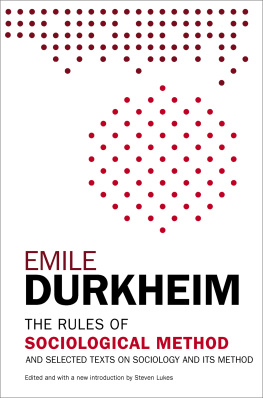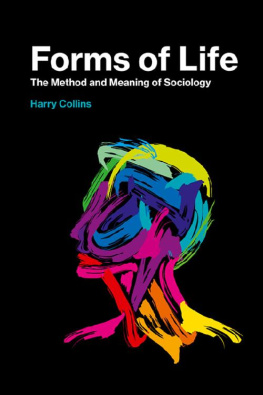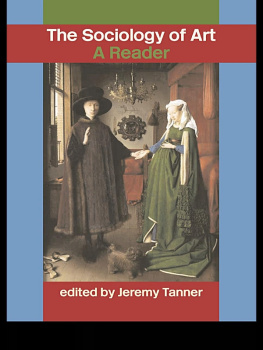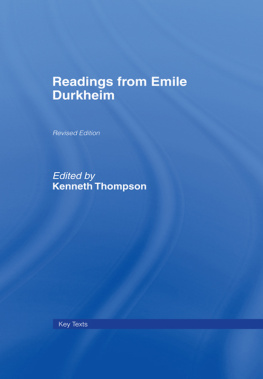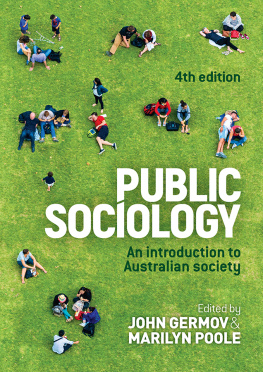Thank you for downloading this Free Press eBook.
Join our mailing list and get updates on new releases, deals, bonus content and other great books from Free Press and Simon & Schuster.
C LICK H ERE T O S IGN U P
or visit us online to sign up at
eBookNews.SimonandSchuster.com
We hope you enjoyed reading this Free Press eBook.
Join our mailing list and get updates on new releases, deals, bonus content and other great books from Free Press and Simon & Schuster.
C LICK H ERE T O S IGN U P
or visit us online to sign up at
eBookNews.SimonandSchuster.com

Free Press
An Imprint of Simon & Schuster, Inc.
1230 Avenue of the Americas
New York, NY 10020
www.SimonandSchuster.com
Introduction to this edition and corrections to translation copyright 2013 by Steven Lukes
Selection and editorial matter copyright 1982, 2013 by Steven Lukes
Translation copyright 1982 by Palgrave Macmillan
This work was previously published by Palgrave Macmillan.
All rights reserved, including the right to reproduce this book or portions thereof in any form whatsoever. For information address Free Press Subsidiary Rights Department, 1230 Avenue of the Americas, New York, NY 10020.
This Free Press trade paperback edition February 2014
FREE PRESS and colophon are trademarks of Simon & Schuster, Inc.
The Simon & Schuster Speakers Bureau can bring authors to your live event. For more information or to book an event contact the Simon & Schuster Speakers Bureau at 1-866-248-3049 or visit our website at www.simonspeakers.com.
Cover design by Jason Heuer
ISBN 978-1-4767-4972-3
ISBN 978-1-4391-1837-5 (ebook)
Contents
Notes on
Letters about
Preface to This Edition
The story of English translations of Durkheims major works has not been an especially happy one. The earliest translationsof Elementary Forms of Religious Life (Durkheim 1915), The Division of Labor in Society (Durkheim 1933) and The Rules of Sociological Method (Durkheim 1938)were defective, sometimes seriously so. (should one, for instance, respect the authors unclarities and ambiguities or help the reader by plumping for precision?) and in part because the barriers separating a past author from present readers tend to rise up with time and generational change (so should the translator try to lower them?).
The present edition of The Rules offers the reader a revised version of that published in 1982. It includes a chronology of Durkheims life and works and suggestions for further reading. The revisions to the translation are intended to attain maximum precision, both linguistic and conceptual, where the English can be rendered closer to the French, which sometimes means strengthening and sometimes weakening the earlier renderings of what Durkheim wrote. They also aim at consistency of usage of key terms within the text. And they seek fidelity to Durkheims intentionswhat he was meaning to say, insofar as this is ascertainablewhich sometimes means opting for vagueness and ambiguity and even for anachronism where implicit reference is made to a past thinker or school of thought. I want here to acknowledge the invaluable assistance of Raphaelle Thery, who meticulously checked the entire translation. The original French volume of Les rgles de la mthode sociologique (second edition), published in 1901, which is translated here, contained, according to the convention of the time, an extended table of contents. This is included here, following the text of the book, in order further to aid readers in navigating the text.
Durkheims intentions were in the process of development and it is important to note that The Rules is a transitional work. As Durkheim himself notes, in his letter to the Revue no-scolastique responding to Simon Deploige, included here, it was precisely in 1895, when The Rules was published as a book, that he found a means of tackling sociologically the study of religion (199). That year, he wrote, marked a watershed in my thinking, so much so that all my previous research had to be started all over again so as to be harmonized with these new views. That is one reason for the inclusion of Durkheims subsequent methodological reflections, in the form of debates with fellow scholars from neighboring disciplines, short notes and letters, so that the enterprising reader can trace continuities and changes in relation to the positions taken in the text of The Rules. For guidance in this such a reader should find helpful Durkheims Preface to the second edition of the book, published in 1901, in which he seeks to defend those positionsor better, perhaps, reformulate them in order to render them, or so at least he thought, more defensible.
What should be evident from these textsfrom Durkheims combative manifesto for sociology, from the objections of his numerous critics and from his energetic responses to these over timeis that they center on issues that are still very much alive within sociology and, more widely, in the social sciences at large. Here the reader will find debated a range of questions to which there are still today no settled, agreed-upon answers. Is the doctrine of methodological individualism successfully refuted by what is now called the concept of emergence? And how are we to decide when the evidence confirms and when it decisively refutes theories in the social sciences?
Notes
The worst example is the omission from the Solovay and Mueller translation of The Rules (Durkheim 1938) of an entire paragraph, about structural or morphological facts forming the substratum of collective life, that is essential to the argument of the first chapter of The Rules and indeed, as I argue here in the Introduction, to understanding the development of Durkheims thought. For a list of the more egregious mistranslations in The Rules and The Division , see appendix to Lukes 1968. For discussions of Swains translation of Elementary Forms see Fieldss introduction to Durkheim 1995 and Fields 2005. For a general discussion of these issues see Lukes 2012.
The situation regarding Durkheims Suicide differs from that of the other three works cited. Here the earlier translation (Durkheim 1951) is adequate and serviceable, whereas the new translation, though generally accurate and easy to read, makes bad decisions, translating goisme throughout as egotism, which suggests selfishness, whereas Durkheim intended isolation and detachment, which egoism (used in the earlier translation) allows. It also specifies the meaning of Durkheims socit a term he notoriously left undefinedin different ways at different points, thereby masking Durkheims uncertainty and unclarity as to the meaning of this crucial word.
For a forceful present-day defense of the concept of emergence, advancing a relational theory of emergent properties as applicable to the analysis of the social world, see Elder-Vass 2010.
See the remarkable book by John Levi Martin (2011), which sharply disputes this idea (citing Durkheims endorsement of it on p. 143), in the service of a broader argument which contests the very idea, prevalent in the social sciences, that the most important sort of explanation is one that comes in the form of a third-person answer to a why question (p. 24). For Levi Martin the social sciences have gone seriously astray by inheriting from Freud and from Durkheim inappropriate and untenable conceptions of causation and explanation.
References
Canguilhem, Georges 1991. The Normal and the Pathological. Translated by Catherine R. Fawcett with an Introduction by Michel Foucault. Brooklyn, NY: Zone Books (first published in French in 1943 and a fuller version in 1966).
Next page
